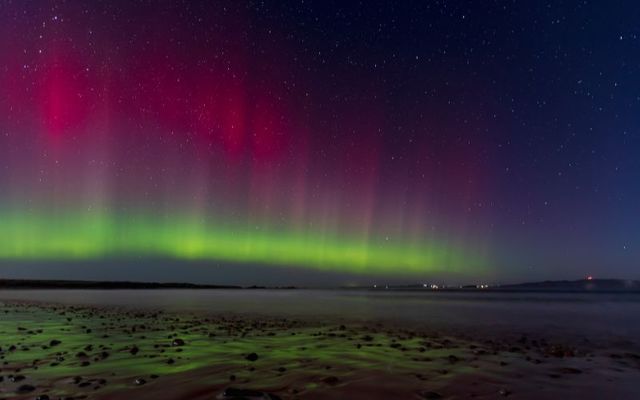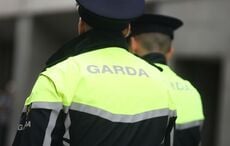Ireland was treated to a rare yet dazzling display of the Aurora Borealis, aka the Northern Lights, on Sunday night, February 26, and Monday night, February 27.
"It's not often that we get a major display of the Northern Lights visible from Ireland," David Moore, the head of Astronomy Ireland, told the Co Mayo-based CRCFM on Tuesday evening.
Moore said "the skies played ball" on Sunday and Monday night, allowing lots of people across the island of Ireland to witness the Northern Lights and capture stunning photos and time lapses of the rare events.
“It was just unbelievable, really," Alan O’Reilly, who runs the Carlow Weather accounts on social media, said on RTÉ Radio on Monday.
O'Reilly described the Northern Lights display in Ireland over the past few days as a "very rare event" and said that it was "amazing to be able to see it so far south here as in Carlow."
He added: “It has happened on a couple of occasions, but not as strong as this.
“This was probably the strongest display in a long, long, long time.
“A lot of people captured them in Donegal and Sligo and they were seeing it with the naked eye and the images they were capturing there were even more amazing.”
Explaining why the northern lights were visible so far south in Ireland, O’Reilly said: “We now have a G3 geomagnetic storm, but we had a CME [Coronal Mass Ejection] which is basically solar flare activity.
“So a sunspot on the sun erupts and sends a flare, in simple terms, towards Earth.
“It’s all to do with a lot of different variables that have to come together in terms of the direction, as well, and the timing of it.”
I managed to capture the Northern Lights with my drone on long exposure above my house just now! pic.twitter.com/7HG6HcPguA
— Carlow Weather (@CarlowWeather) February 26, 2023
What are the Northern Lights?
As per Ireland's meteorological service Met Éireann, the Northern Lights (or Aurora borealis in the northern hemisphere) are the results of collisions between gas particles in our atmosphere and charged particles ejected from the Sun’s atmosphere.
The color of the Northern Lights will change due to the type of gas particles that are colliding. Oxygen molecules at approximately 100 km above the earth produce a greenish-yellow color while, while a red aurora can be seen when high-level oxygen molecules are involved. Blue or purple auroras indicate the presence of nitrogen molecules.
The hotter it is, the more energy is available, Met Éireann says. This leads to collisions between gas molecules and at such high temperatures, these collisions can be explosive. As the Sun rotates, particles are ejected through holes in its magnetic field. These charged particles make up the solar wind and this wind carries the free particles toward the Earth’s atmosphere.
Generally speaking, these charged particles are deflected by the Earth’s magnetic field, but at the poles, the magnetic field is weaker, and because of this some of these particles enter the Earth’s atmosphere and collide with gas particles. The collisions produce light and this is what we call the Northern Lights.
Met Éireann says that the Northern Lights are best observed in locations with very small amounts of light pollution. Parts of the west and north coast of Ireland would offer the greatest chance of seeing the display.
There are a number of forecast services for the Northern Lights, including the National Oceanic and Atmospheric Administration (NOAA), which provides a 30-minute forecast for the Aurora.
On social media, people around Ireland shared their stunning captures of the Northern Lights on Sunday and Monday nights.
Dunluce Castle in Northern Ireland:
What a show of the Northern lights we had on Sunday 26th February. Dunluce Castle, Northern Ireland. @chunder10 @TamithaSkov @DiscoverNI @bbcniweather @TourismNIreland pic.twitter.com/QKol5C6YHt
— North Coast Snapper (@Northcoastsnap) February 28, 2023
Connemara in the west of Ireland:
Magic Connemara nights under the stars. The milky way arching over this fishing hut and if you look in the center of the frame you can see faint purple glow of the northern lights. Special ?? @UKNikon Z6 and 24mm 1.8. @ConnemaraIe @galwaytourism #ireland pic.twitter.com/tYoJvk1ugT
— Sean O' Riordan (@seanorphoto) February 26, 2023
Sligo in the northwest of Ireland:
View this post on Instagram
Inishbofin off the coast of Co Galway:
View this post on Instagram
Scenes from Co Mayo on Monday night:
OMG @CarlowWeather @MetEireann @rte pic.twitter.com/uvurH0M8sa
— Caroline Sweeney (@legancastle) February 27, 2023




Comments